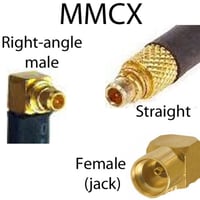Bulkhead Nut & Washer for RP-SMA & SMA: Mount Connector on Enclosure or PCB
- SKU:
- BHNW
- Availability:
- In stock
- Weight:
- 0.01 LBS
Data Alliance
Bulkhead Nut & Washer for RP-SMA & SMA
Nut and washer for RP-SMA-female and SMA female connector: Bulkhead nut & washer to mount connector on enclosure or PCB. SMA and RP-SMA use the same hex nut and washer set. Options for rustproof and waterproof RP-SMA and SMA connectors: Choose Nickel if you need long-term rustproof - the most corrosion-resistant option (details below).
The purposes of the bulkhead on an SMA-female or RP-SMA-female are to:
- Enable the connector to serve as a mounting device, such as to mount the cable to an enclosure, case or Printed Circuit Board (PCD).
- Weatherproofing: Seal the hole where the connector is mounted, by placing an O-ring between the wall of the enclosure and the O-ring.
- Waterproof Rating: Using this O-ring with the bulkhead nut and washer (100% brass version) on an SMA or RP-SMA-female connector results in the connector having an IP68 rating.
The bulkhead does not in any way interfere with the ability of a female connector to properly "mate" with a male connector: In other words, a female connector with a bulkhead mates/connects exactly as well as a female connector without a bulkhead.
The hex nut for SMA and RP-SMA measures 5/16 inch (0.3125 inch / 7.9 mm) across opposite flats: The SMA wrench that fits it is the same wrench as for a #6 SAE hex nut.
The bulkhead set includes one nut and one washer.
The inside diameter is 6mm, to clear the threads on the female connector.
Rubber waterproof O-ring seal can be purchased by checking the checkbox above or purchase as a standalone item.
RoHS and REACH compliant: All of our antenna cables and RF adapters are from of heavy metals and compliant with RoHS and REACH.
Gold-Plated Brass & Nickel-Plated Brass Options
- All of our Brass options are gold-plated. Gold-plating is better in appearance and more expensive than nickel-plated one.
- For indoor applications: Gold-plated brass alloy is the best option, because gold-plating is more attractive.
- For outdoor applications: Nickel-plated brass is the best option to weatherproof SMA and RP-SMA antenna connectors (read more below).
Rust Proofing and Corrosion-Protection: Best Options Among Nickel, Gold-Plated Brass & Brass Alloys:
- Nickel-plated brass is the most corrosion-resistant option:
- Nickel does not decompose as it oxidizes, but forms a layer of nickel-oxide that prevents further oxidation from occurring.
- Nickel-plating is achieved by electro-plating the brass nuts and washers with a thin layer of nickel.
- The result is nuts & washers that are highly resistant to rust /oxidation and verdigris (those green spots that show up on old brass)
- Rust Proofing and Corrosion-Protection is Achieved in our 100% Brass w/Gold Plate Version By:
- Keeping zinc content below 15%
- Adding in other metals to the alloy such as arsenic, phosphorus, antimony, and tin
With Zinc content below 15%, brass alloys can be rust-proof as long as:
- Aeration is kept at a minimum.
- The brass is kept away from oxidizing materials that include cyanides, ammonia, dichromates, and nitric acid.
- Reactive materials such as acetylene, silver salts, mercury, hydrogen sulphide, and sulphur are not present
- The components are kept away from salt, chemicals in the air, tap water, and rainwater.
Factors that Affect the Corrosion of your Brass Alloy Components
- Brass alloy components and equipment that are outside will lose their luster faster than those kept inside in a dry building, which can remain shiny for years.
- Components near roads that are salted frequently, or near any marine or salty environments will corrode faster than those near freshwater water bodies.
- Brass alloys submerged in water will lose their zinc component faster and become fragile as compared to those exposed to just air. Outside of situations where you need to submerge the metal in water, brass is excellent for outdoor applications as it is one of the most corrosion proof metal alloys. Once its surface is oxidized and changes to a blue-green hue, it can last for hundreds of years without corroding or losing its structural integrity.
Gold-Plated Brass & Brass Alloys used in Rust-Proofing
- Brass is an alloy of zinc and copper.
- Zinc composition can range from as low as 5% to as high as 45%, with the percentage of copper increased or decreased proportionately.
- The corrosion resistance of the brass will typically reduce as the percentage zinc in the alloy is increased.
Rustproofing for brass is not the same thing as what you do for metals such as aluminum, iron or stainless steel which contain iron. Brass does not contain iron and hence it does not rust in the true sense of the word. Brass corrodes.
Brass will react with air to form a copper oxide which is a dark grey corrosion film that covers the metal and prevents further damage. The film can be washed away by abrasive materials such as salt water, industrial chemicals, and even fast flowing liquids, leaving the metal vulnerable to more corrosion.
Brass can also corrode through dezincification: The metal loses its zinc content when exposed to alkaline, neutral and acidic media.
















